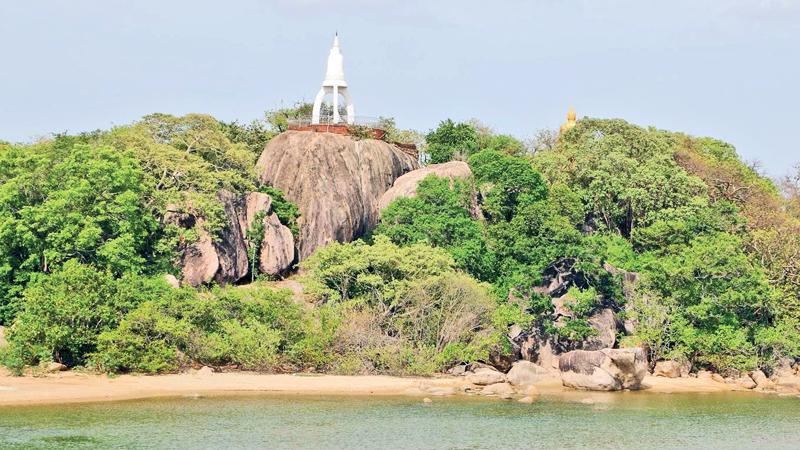
The Lankapatuna Vihara commonly known as the Lankapatuna Samudragiri Vihara in Trincomalee is one of the most ancient temples in Sri Lanka.
The temple is close to the ocean and also close to the historical port of Lankapatuna where Prince Dantha and Princess Hemamala set foot in Sri Lanka bringing the sacred Tooth Relic of the Buddha in the 4th century A.D.
This sacred site is surrounded by the sea from the East and by the Ullakkuliya lagoon from the West.
The temple, believed to have been built near the entrance of the port for the worship of merchants and travellers, is on an elevated rock that sticks out of the shoreline of the Ullakkuliya lagoon.
If you look around from the top of the rock where the Dagaba is, your eyes will catch a breathtaking scenery.
The area is now called “Ilankathurai”. The legend has it that the Prince Dantha and the Princess Hemamala who had reached the place in the evening had stayed there performing poojas and other religious rites with the help of the Brahmin who was at the Giri Devala on the rock. In the following morning, they went to Anuradhapura and handed over the Sacred Tooth Relic to King Kithsiri Mewan.
The Lankapatuna temple stood near the shores of Trincomalee for many years. Unfortunately, due to the war and the tsunami, some important historical factors and landmarks have been damaged. But the location still has a wonderful historical value. The ruins of an ancient dagaba, a korawakgala, a pond and other ruins of the ancient temple are still visible.
Pura Vidya Chakrawarthi Ven. Ellawala Medhananda Thera who had visited the site in 1965 had reported about the ruins scattered at the place including the remnants of an ancient Buddhist stupa of about 6 feet tall. The Thera has stated about the destruction caused to the sacred site by terrorist activities in his book titled “Buddhist Heritage in the Eastern Province.
As the old bridge was destroyed by terrorists and a 150-metre new bridge was constructed in 2019, the temple was renovated and a new stupa was constructed to replace the one which had fallen into ruins.
A flight of stairs belonging to the Anuradhapura period was discovered through excavations at the site.
According to historical records, the sacred site had been discovered in 1940 by Ven. Dambagasare Sri Sumedhalankara Nayaka Thera and the foundation stone for a Sangawasa for the bhikkhus had been laid in 1982 under the guidance of Chief Sangha Nayaka of the Eastern Province Ven. Seruwila Saranakiththi Thera. Chief Incumbent of the temple Ven. Bandarawela Sumedha Thera said that it has been revealed that several buildings had been built at this site for bhikkhus during the Anuradhapura era.
Sea beach with a lagoon
Other than the temple site, there are several features that are touristically important. The beautiful sea beach with a lagoon is a paradise for tourists. The beach with mild sand, the vegetation which is endemic to the area create an elegant view. The small thicket on which the temple is situated is also very unique. Those who visit the place can also visit more sacred places such as Somawathiya temple and Sri Palamugar Hindu Kovil and foul point of the light house.
The remaining ruins of this site are being researched by the archaeologists who believe them to be historically and culturally important.
Chief Incumbent of the temple Ven. Sumedha Thera said, “We developed this sacred site with dedication and the assistance of the Sri Lanka Army and the Navy. The pilgrims too have helped us in numerous ways for this worthy cause. We built a resting hall for pilgrims.”

